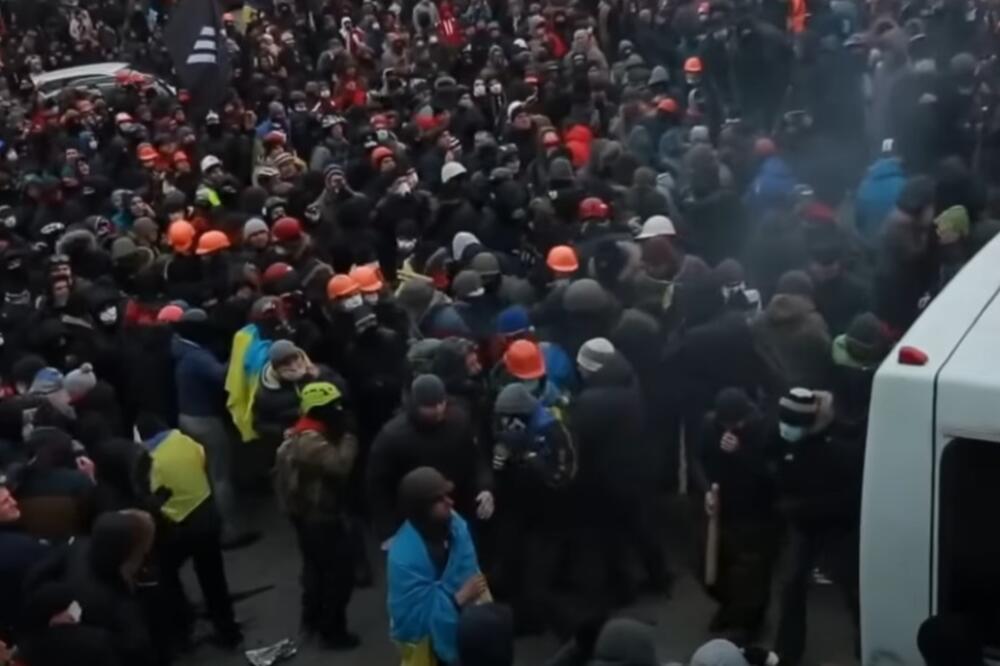When journalists undergo security training, they are advised to seek shelter along the walls of houses in cities, in dangerous situations, not to walk in the middle of the street. "As soon as it clears, and you have to cross the street - run," advise former elite soldiers on such courses.
These are tips you hope you never have to use as a correspondent. But on February 20, 2014, it became necessary to stick to those tips. There was shooting in the Ukrainian capital, Kiev.
Previously, since the end of November, tens of thousands of people protested there against the government of President Viktor Yanukovych, who, apparently under pressure from Russia, did not want to sign the association agreement with the EU. Demonstrators gathered in the square, and more and more of them, despite the brutal actions of the police. Until the situation completely escalated at the end of February.
Dangers on the road
From the apartment where ARD's small studio was then, it is only a few hundred meters to the Maidan. But going there directly is life-threatening, because there are snipers lurking along Institutska Street.
Instead, you go to Maidan in a wide arc. The road leads downhill, to Krešatik, which leads to Maidan. That boulevard is closed with barricades. Smoke can be seen from afar, gunshots are heard.
Maidan itself is unrecognizable. The trade union house burned down, the blocks that paved the square were broken. Everything turns black. Only charred remains remain of the tents that the protesters erected there several weeks ago.
Lured into a trap
Horror is visible on people's faces. Throughout the night, they fought street battles with the police. Stones and Molotov cocktails were flying. In the morning, the police suddenly retreated past the Ukraina Hotel and along Institutska Street. The protesters ran after them – to their deaths. They shot at them.
Later, uniformed snipers with special rifles could be seen in the videos. Police officers were also killed, probably from shots fired by protesters. In the morning, broken helmets and bulletproof vests were scattered around the square - some were made by the protesters themselves, some were stolen from the police.
Dead in the hotel lobby
We continue across the square to Hotel Ukraina, where a room was reserved for the ARD correspondent. However, it turned out that the entrance was blocked. A doctor comes out, followed by six men with stretchers. On them is a seriously wounded man. He was shot in the head, blood is flowing on the stretcher. Videographers with cameras follow them and record everything.
In the lobby of the hotel - a strange sight: the right side is covered with sheets, the left has become an operating theater. Doctors and nurses who have volunteered are standing next to ordinary tables on which the wounded lie. Blood everywhere, and the atmosphere – eerily calm. Helpers wipe the tables.
Some women at the hotel reception are crying. Some others can be heard sobbing from behind improvised curtains. It becomes clear that the murdered and their relatives lie there. Death behind white sheets.
Better not take the stairs
Hotel Ukraina is a typical Soviet edifice – a tall building with 16 floors rising above the Maidan. It offers an ideal view of Independence Square, as it is actually officially called the Maidan.
The correspondent's room is on the fourth floor. On the way there, one goes up the stairs past the barred windows. A colleague recommends taking the elevator, not the stairs. There is still shooting outside.
The room overlooks Institute Street. There were snipers there. And maybe they're still there. Draw the curtains, turn off the lights - this is also learned in training. A quick look at the news agencies - they say there are 80 dead. A dozen of them lie behind the curtain, down in the hotel lobby.
Weeks later, one sports expert says he carefully reviewed the footage recorded that day. The movements of the snipers when they target the demonstrators show that they must have been absolute professionals and not ordinary policemen.
Search for snipers
Doctors and their assistants form a barricade in the hotel lobby. The curtains are drawn, the dead are brought out. Those standing sing the national anthem of Ukraine. With tears in his eyes. Since the start of the protests on the Maidan, the anthem could be heard every hour, day and night.
Late at night - a knock on the door. In front of them stands a young man, an activist from the Maidan. He wears a helmet and holds a metal shield. He enters and pulls aside the curtains. He wanted to see if there were any snipers hiding here. Then he leaves.
A sleepless night
It is difficult to fall asleep at night. Clothes and boots don't come off, in case you need to get out of the building quickly. Journalists were repeatedly warned that the hotel could be set on fire. It is a strategically important building, from which you can see the entire Maidan.
Sleep does not come because the body is full of adrenaline. The meal is cookies, chocolate and water, bought in a small shop on the way to the hotel. The hotel restaurant stopped working a few days ago.
A barricade is burning outside. The light of the fire can be seen through the drawn curtain. The night is short. Maybe three hours of shallow sleep, interrupted several times by gunshots. At seven in the morning on that February 21st, three hours of live coverage of the ARD radio station program – crouching behind the bed, to at least somewhat protect himself in case someone shoots at the window.
Reports on the number of dead and injured, on doctors. And then the decision: pack your things and get out of there. Take the elevator, not the stairs. The hall has been cleared in the meantime.
Shock and cheers
A few meters back to Maidan. Tens of thousands of people are standing there. They are still shocked by what happened the previous day. At least a hundred people died. On the big stage are police officers from Lviv in western Ukraine who joined the Maidan movement. They shout at them.
Krešatik Boulevard with eight lanes also became part of the revolution in the square. In front of the square itself, there is only the last barricade, one meter high. Commemoration for the dead begins on the Maidan.
The author of this article, Bernd Grosheim, was ARD's Moscow correspondent from 2013 to 2016. During that time, he reported on events in Ukraine, including from Kyiv, Donetsk, Kharkiv and Mariupol.
Bonus video:





